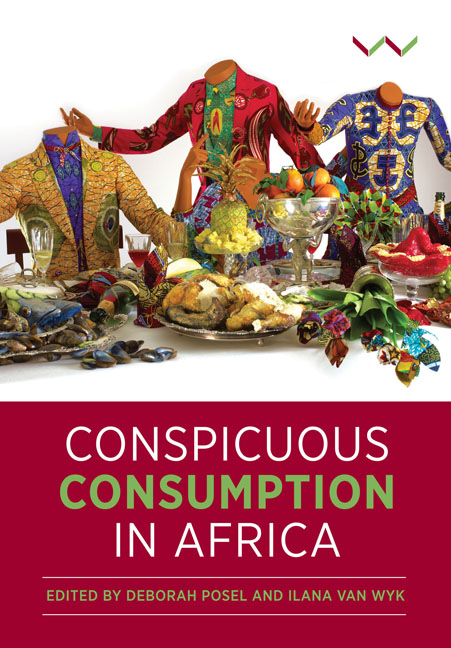Book contents
- Frontmatter
- Contents
- Acknowledgements
- List of Illustrations
- 1 Thinking With Veblen: Case Studies From Africa's Past and Present
- 2 Changes in the Order of Things: Department Stores and the Making of Modern Cape Town
- 3 Conspicuously Public: Gendered Histories of Sartorial and Social Success in Urban Togo
- 4 Etienne Rousseau, Broedertwis and the Politics of Consumption Within Afrikanerdom
- 5 Recycling Consumption: Political Power and Elite Wealth in Angola
- 6 Chiluba's Trunks: Consumption, Excess and the Body Politic in Zambia
- 7 Jacob Zuma's Shamelessness: Conspicuous Consumption, Politics and Religion
- 8 Precarious ‘Bigness’: a ‘Big Man’, His Women and His Funeral in Cameroon
- 9 Young Men of Leisure? Youth, Conspicuous Consumption and the Performativity of Dress in Niger
- 10 Booty on Fire: Looking at Izikhothane With Thorstein Veblen
- 11 Conspicuous Queer Consumption: Emulation and Honour in the Pink Map
- 12 The Politics and Moral Economy of Middle-Class Consumption in South Africa
- 13 Marigold Beads: Who Needs Diamonds?!
- Contributors
- Index
11 - Conspicuous Queer Consumption: Emulation and Honour in the Pink Map
Published online by Cambridge University Press: 29 October 2019
- Frontmatter
- Contents
- Acknowledgements
- List of Illustrations
- 1 Thinking With Veblen: Case Studies From Africa's Past and Present
- 2 Changes in the Order of Things: Department Stores and the Making of Modern Cape Town
- 3 Conspicuously Public: Gendered Histories of Sartorial and Social Success in Urban Togo
- 4 Etienne Rousseau, Broedertwis and the Politics of Consumption Within Afrikanerdom
- 5 Recycling Consumption: Political Power and Elite Wealth in Angola
- 6 Chiluba's Trunks: Consumption, Excess and the Body Politic in Zambia
- 7 Jacob Zuma's Shamelessness: Conspicuous Consumption, Politics and Religion
- 8 Precarious ‘Bigness’: a ‘Big Man’, His Women and His Funeral in Cameroon
- 9 Young Men of Leisure? Youth, Conspicuous Consumption and the Performativity of Dress in Niger
- 10 Booty on Fire: Looking at Izikhothane With Thorstein Veblen
- 11 Conspicuous Queer Consumption: Emulation and Honour in the Pink Map
- 12 The Politics and Moral Economy of Middle-Class Consumption in South Africa
- 13 Marigold Beads: Who Needs Diamonds?!
- Contributors
- Index
Summary
The cover of the inaugural 1999 edition of the Pink Map: The Gay Guide to Cape Town featured an image of a colourful peacock – a flamboyant creature itself – made more extraordinary by the addition of a dazzling pink triangle crest on top of its head. The Map, as well as the ostentatious image itself, was not the start of queer leisure consumption in Cape Town, but certainly served as a sign of the emergence of a more tangible queer pleasure periphery in the city as South Africa transitioned from decades of apartheid rule. While queer individuals and communities in Cape Town began to emerge slowly into mainstream society, they also became more conspicuous consumers and as tourists, the definitive leisure class (Veblen 2008 [1899]), emulated a global standard of queer identity and consumption amongst the numerous others exercising their freedom to consume (Posel 2010). As the city of Cape Town began to realise the potential impacts of the lesbian, gay, bisexual and transgender (LGBT) oriented tourist industry on the local economy, the city's tourism authority began to market Cape Town actively as a gay-friendly destination. This active and identity-based place promotion materialised in the form of the Pink Map, an annual publication that, since 1999, has attempted to map the city's queer leisure spaces for LGBT visitors, while also serving as material evidence of the shaping of queer destination space (Rink 2013).
My analysis of 14 editions (from 1999 to 2012) of the Pink Map, using Thorstein Veblen's (2008) theory of conspicuous consumption as a lens marks the emergence of the queer consumer at the dawn of queer liberation in South Africa through the emulation of an idealised subjectivity based on standard tropes within a global LGBT identity. More than simply mapping the ‘pink’ tourist experience, the Pink Map also serves as an archive of changes in consumption amongst those that Oswin (2006), following Altman (1997), terms the ‘global gay’. In Oswin's analysis, this diffusion of a globalised (and male-centric) queer identity from the West to the non-West is problematic for a number of reasons – not least for its failure to recognise the diversity and lack of buying power across a range of queer individuals.
- Type
- Chapter
- Information
- Conspicuous Consumption in Africa , pp. 183 - 199Publisher: Wits University PressPrint publication year: 2019



